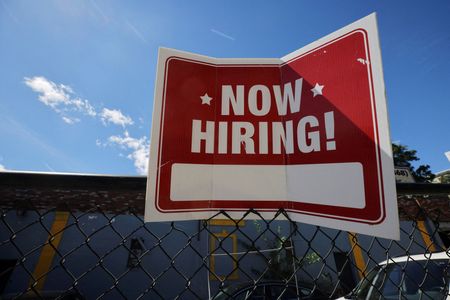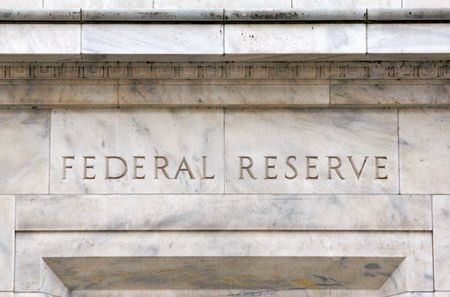By Howard Schneider
WASHINGTON (Reuters) – A jump in U.S. monthly job openings has thrown the Federal Reserve another confounding bit of data for its policy meeting this week, with more evidence that rapid interest rate increases have yet to bite hard in the real economy.
New data released by the Bureau of Labor Statistics on Tuesday showed firms had 10.7 million job openings at the end of September, a jump of about half a million from August in a number the Fed expects to see move lower as demand in the economy slows.
Yields on U.S. Treasury bonds rose after the release of the data, as did bets that the Fed may raise its target policy rate higher than anticipated.
With the central bank widely expected to lift that rate yet again by three-quarters of a percentage point to a range of 3.75% to 4.00% at the end of a two-day meeting on Wednesday, traders are now leaning to a fifth straight hike of that size at the Fed’s final meeting of the year in December, with the target policy rate seen exceeding 5% in March.
Stocks were lower in early afternoon trading.
DIFFICULT TO PIVOT
The job openings data “will make it very difficult for the Fed to pivot” towards a slower pace of rate hikes, as many have expected, Jefferies economists Aneta Markowska and Thomas Simons wrote. “In order to slow the pace of hikes, the Fed needs to be able to make a compelling case that slowing labor demand will take pressure off of labor costs, ultimately slowing inflation. It’s difficult to make that case after today’s report.”
The new data means there were more than 1.85 jobs available for each person estimated to be formally unemployed in September, an increase from August in a data point that Fed Chair Jerome Powell has said he watches closely for evidence U.S. labor markets are becoming better aligned between the number of workers firms want to hire and the number of jobseekers.
In the months before the COVID-19 pandemic, when the unemployment rate was also around the current 3.5%, the figure was roughly 1.2.
GRAPHIC: Unemployed to job openings – More jobs than jobseekers https://graphics.reuters.com/USA-FED/JOBS/egvbkmeoepq/chart.png
The Fed has been hiking interest rates aggressively to slow the worst outbreak of inflation in 40 years. Yet prices, as measured by the central bank’s preferred gauge, have continued to rise at about triple its 2% target, while a resilient labor market has strengthened policymakers’ faith that they can continue to push borrowing costs higher if needed without a major hit to jobs.
GRAPHIC: Rates up, inflation sideways, https://graphics.reuters.com/USA-FED/INFLATION/gkvlgnaywpb/chart.png
Another closely watched number from the monthly Job Openings and Labor Turnover Survey showed more than 4 million people quit their jobs in September, roughly half a million more than the levels seen just before the pandemic.
Quits are seen as a sign of labor market strength, evidence that people either have a more attractive option in front of them or are confident of finding one.
The number of people laid off declined in September.
Since the start of the year “there has been some cooling,” in the labor market, with measures like the quits rate coming off of historic highs, said Nick Bunker, head of economic research at Indeed Hiring Lab. But “how much has it moderated? One degree? A couple? Either way it has not dropped fast enough” for an “impatient” Fed.
UNCOOPERATIVE DATA
The jobs openings survey will have little influence over the Fed’s expected approval of a 75-basis-point rate increase at this week’s policy meeting.
But it could shape how officials frame that decision and how it is characterized by Powell in a news conference shortly after the release of the policy statement on Wednesday.
Balanced against the strength of the labor market is evidence that a slowing of inflation may be in the pipeline. Private data, for example, indicates rents are beginning to decline, and a new manufacturing survey showed input prices fell in October – a sign that goods price inflation will also slow.
GRAPHIC: Rent inflation slows https://graphics.reuters.com/USA-FED/INFLATION/zjpqjqezkvx/chart.png
That has not yet been seen in headline inflation numbers, and the combination of high inflation reports and scant evidence that the job market is cracking may leave the Fed in a more aggressive posture, even if it does raise rates in smaller increments at future policy meetings.
Some policymakers, such as Fed Governor Christopher Waller, have said they expect much of the tension in the labor market can be relieved by companies scaling back hiring plans – an outlook that will be foiled if job openings continue to rise.
GRAPHIC: A shift in the Beveridge Curve? https://graphics.reuters.com/USA-FED/JOBS/zgpomomzqpd/chart.png
The jump in job openings “is another example of data ‘not cooperating’ with the Fed’s desire to slow the pace of rate hikes,” Citi analysts wrote. “Resilient data raises further the risk that any slowdown is paired with hawkish communication that policy rates could rise for longer and to higher terminal rates.”
(Reporting by Howard Schneider; Editing by Paul Simao)


